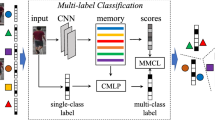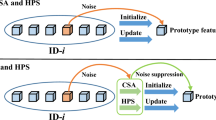Abstract
Unsupervised person re-identification (Re-ID) aims to learn robust and discriminative features with unlabeled data. Recently, more attention of clustering-based methods focus on using cluster centroids and all instances for contrastive learning. However, the previous methods did not fully consider the information of hard samples in clustering process and cluster-level contrastive learning process. In this paper, we propose a novel hard-sample guided cluster refinement (HGCR) approach to learn information of hard samples in a simple but efficient way. Specifically, in HGCR we improve the reliability of clustering-based pseudo labels under the guidance of the historical cluster information. Meanwhile, we introduce class-level and instance-level contrastive learning with a sample filter scheme, which can fully exploit the information of hard positive samples. Extensive experiments on three large-scale person Re-ID benchmarks demonstrate the effectiveness of the proposed method, which outperforms state-of-the-art unsupervised person Re-ID methods by a considerable margin.







Similar content being viewed by others
Availability of data and materials
The data used in this paper is open source. The code of this study will be available at Github.
References
Zheng, L., Yang, Y., Hauptmann, A.G.: Person Re-identification: Past, Present and Future. arXiv preprint arXiv:1610.02984 (2016)
Luo, H., et al.: A strong baseline and batch normalization neck for deep person re-identification. IEEE Trans. Multimedia 22, 2597–2609 (2020)
Ning, X., et al.: Feature refinement and filter network for person re-identification. IEEE Trans. Circuits Syst. Video Technol. 31, 3391–3402 (2021)
Lei, J., et al.: Person re-identification by semantic region representation and topology constraint. IEEE Trans. Circuits Syst. Video Technol. 29, 2453–2466 (2019)
Shu, X., et al.: Large-scale spatio-temporal person re-identification: Algorithms and benchmark. IEEE Trans. Circuits Syst. Video Technol. 32, 4390–4403 (2022)
Dai, Y., Liu, J., Bai, Y., Tong, Z., Duan, L.-Y.: Dual-refinement: joint label and feature refinement for unsupervised domain adaptive person re-identification. IEEE Trans. Image Process. 30, 7815–7829 (2021)
Ge, Y., Chen, D., Li, H.: Mutual Mean-Teaching: Pseudo Label Refinery for Unsupervised Domain Adaptation on Person Re-identification. arXiv preprint arXiv:2001.01526 (2020)
Fu, Y., et al.: Self-similarity grouping: a simple unsupervised cross domain adaptation approach for person re-identification, pp. 6111–6120 (2019)
Lin, Y., Dong, X., Zheng, L., Yan, Y., Yang, Y.: A bottom-up clustering approach to unsupervised person re-identification 33, 8738–8745 (2019)
Zhang, X., Ge, Y., Qiao, Y., Li, H.: Refining pseudo labels with clustering consensus over generations for unsupervised object re-identification, pp. 3435–3444 (2021)
Cho, Y., Kim, W. J., Hong, S., Yoon, S.-E.: Part-based pseudo label refinement for unsupervised person re-identification, pp. 7298–7308 (2022)
Dai, Z., Wang, G., Yuan, W., Zhu, S., Tan, P.: Cluster contrast for unsupervised person re-identification, pp. 1142–1160 (2022)
Li, M., Li, C.-G., Guo, J.: Cluster-guided asymmetric contrastive learning for unsupervised person re-identification. IEEE Trans. Image Process. 31, 3606–3617 (2022)
Qi, L., et al.: Adversarial camera alignment network for unsupervised cross-camera person re-identification. IEEE Trans. Circuits Syst. Video Technol. 32, 2921–2936 (2022)
Peng, J., Jiang, G., Wang, H.: Adaptive memorization with group labels for unsupervised person re-identification. IEEE Trans. Circuits Syst. Video Technol. 33, 5802–5813 (2023)
Cheng, D., Zhou, J., Wang, N., Gao, X.: Hybrid dynamic contrast and probability distillation for unsupervised person re-id. IEEE Trans. Image Process. 31, 3334–3346 (2022)
Ge, Y., Zhu, F., Chen, D., Zhao, R., et al.: Self-paced contrastive learning with hybrid memory for domain adaptive object re-id. Adv. Neural Inf. Process. Syst. 33, 11309–11321 (2020)
Si, T., He, F., Zhang, Z., Duan, Y.: Hybrid contrastive learning for unsupervised person re-identification. IEEE Trans. Multimedia, pp. 1–1 (2022)p
Ester, M., Kriegel, H.-P., Sander, J., Xu, X., et al.: A density-based algorithm for discovering clusters in large spatial databases with noise. 96, 226–231 (1996)
MacQueen, J.: Some methods for classification and analysis of multivariate observations, 281 (1965)
Hu, Z., Zhu, C., He, G.: Hard-sample guided hybrid contrast learning for unsupervised person re-identification, pp. 91–95 (2021)
Laine, S., Aila, T.: Temporal Ensembling for Semi-supervised Learning. arXiv preprint arXiv:1610.02242 (2016)
Zeng, K., Ning, M., Wang, Y., Guo, Y.: Hierarchical clustering with hard-batch triplet loss for person re-identification, pp. 13654–13662 (2020)
Chen, H., Lagadec, B., Bremond, F.: Ice: Inter-instance contrastive encoding for unsupervised person re-identification, pp. 14940–14949 (2021)
Wang, X., Hua, Y., Kodirov, E., Hu, G., Robertson, N.M.: Deep metric learning by online soft mining and class-aware attention 33, 5361–5368 (2019)
Wu, Z., Xiong, Y., Yu, S.X., Lin, D.: Unsupervised feature learning via non-parametric instance discrimination, pp. 3733–3742 (2018)
Hermans, A., Beyer, L., Leibe, B.: In defense of the triplet loss for person re-identification. arXiv preprint arXiv:1703.07737 (2017)
Zhao, X., Dou, X., Zhang, X.: Cluster-aware diversity samples mining for unsupervised person re-identification, pp. 1707–1712 (2022)
Liu, Y., Ge, H., Sun, L., Hou, Y.: Complementary attention-driven contrastive learning with hard-sample exploring for unsupervised domain adaptive person re-id. IEEE Trans. Circuits Syst. Video Technol. 33, 326–341 (2023)
Chen, Z., Cui, Z., Zhang, C., Zhou, J., Liu, Y.: Dual clustering co-teaching with consistent sample mining for unsupervised person re-identification. IEEE Trans. Circuits Syst. Video Technol, pp. 1–1 (2023)
Chen, Y., et al.: Refining noisy labels with label reliability perception for person re-identification. IEEE Trans. Multimedia, pp. 1–12 (2023)
Miao, Y., Deng, J., Ding, G., Han, J.: Confidence-guided centroids for unsupervised person re-identification. arXiv preprint arXiv:2211.11921 (2022)
Zheng, L. et al. Scalable person re-identification: a benchmark, pp. 1116–1124 (2015)
Ristani, E., Solera, F., Zou, R., Cucchiara, R., Tomasi, C.: Performance measures and a data set for multi-target, multi-camera tracking, pp. 17–35 (2016)
Sun, X., Zheng, L.: Dissecting person re-identification from the viewpoint of viewpoint, pp. 608–617 (2019)
He, K., Zhang, X., Ren, S., Sun, J.: Deep residual learning for image recognition, pp. 770–778 (2016)
Deng, J., et al.: Imagenet: a large-scale hierarchical image database, pp. 248–255 (2009)
Kingma, D. P., Ba, J.: Adam: A method for stochastic optimization. arXiv preprint arXiv:1412.6980 (2014)
Li, S., Yuan, M., Chen, J., Hu, Z.: Adadc: Adaptive deep clustering for unsupervised domain adaptation in person re-identification. IEEE Trans. Circuits Syst. Video Technol. 32, 3825–3838 (2022)
Wang, M., Lai, B., Huang, J., Gong, X., Hua, X.-S.: Camera-aware proxies for unsupervised person re-identification 35, 2764–2772 (2021)
Xuan, S., Zhang, S.: Intra-inter camera similarity for unsupervised person re-identification, p. 11921 (1930)
Zheng, Y., et al.: Online pseudo label generation by hierarchical cluster dynamics for adaptive person re-identification, pp. 8351–8361 (2021)
Van der Maaten, L., Hinton, G.: Visualizing data using t-sne. J. Mach. Learn. Res., 9 (2008)
Funding
This work was supported in part by the Natural Science Foundation of Shaanxi Province under Grant 2023-JC-YB-501.
Author information
Authors and Affiliations
Corresponding author
Ethics declarations
Ethical approval
This declaration is not applicable.
Additional information
Publisher's Note
Springer Nature remains neutral with regard to jurisdictional claims in published maps and institutional affiliations.
Rights and permissions
Springer Nature or its licensor (e.g. a society or other partner) holds exclusive rights to this article under a publishing agreement with the author(s) or other rightsholder(s); author self-archiving of the accepted manuscript version of this article is solely governed by the terms of such publishing agreement and applicable law.
About this article
Cite this article
Zhang, C., Su, Y., Wang, N. et al. Hard-sample guided cluster refinement for unsupervised person re-identification. SIViP 19, 39 (2025). https://doi.org/10.1007/s11760-024-03695-z
Received:
Revised:
Accepted:
Published:
DOI: https://doi.org/10.1007/s11760-024-03695-z




